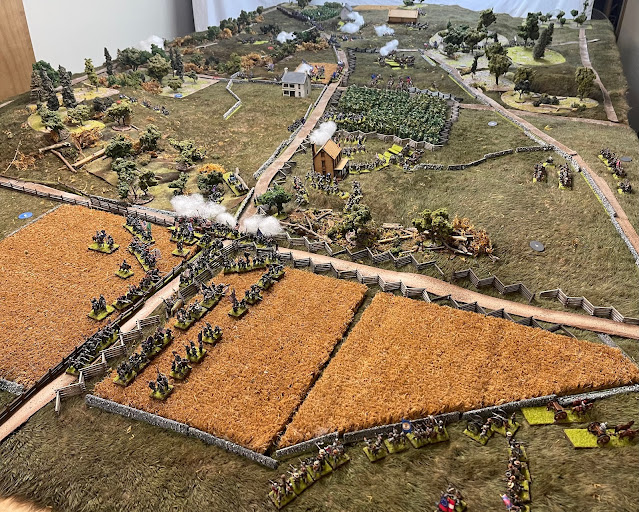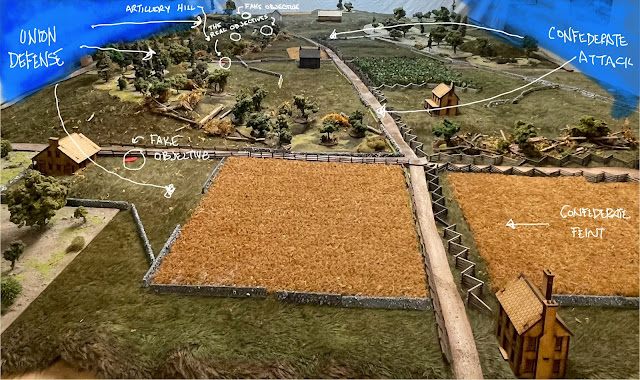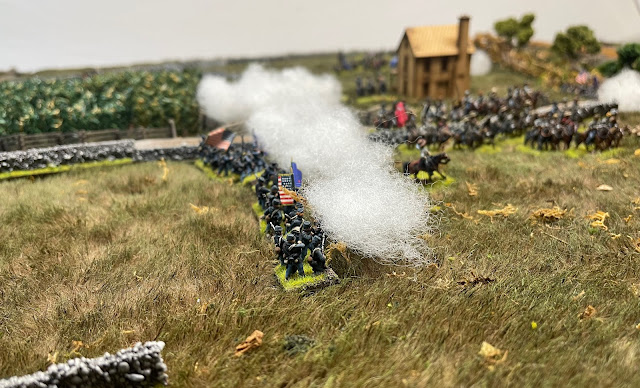Dusk approached the battlefield near the little town of Shaunsville. Less than two hours remained for the Confederate forces to score the breakthrough that could cut off the Union retreat and bag the entire Federal army. The Army of the Potomac was holding on but barely.
 |
| The battle rages on looking across from the Confederate left. |
The Union generals didn’t know it but the three objectives that were the target of the Confederate attack were on Birney’s hill in the center right of the Union line, on Artillery hill in the Union center left and along the fenced road on the Union left. The Confederates had selected the objective on the far Union left but the objective was moved unknowingly during set up when the Union generals swapped it for the objective that had been on artillery hill as part of the rules of set up that allowed them to switch two objectives of their choice
7:20pm-9:00pm (Dusk)
The Union army held on for darkness. On the Union far right the division of Hays continued to hold a strong position along a wall on the edge of a large wheat field. After initially bristling at a Confederate brigade positioned across the wheat field, Hays pulled his division back and sent one of his brigades through the woods to his left and in the rear of Birney’s division near the center of the field. Hays also pushed an artillery battery into a gap through some woods on the left of his front line, turned it and blasted advancing Confederates in flank as they tried to push up the hill in Birney’s sector.
The aforementioned division of Birney finally had a second brigade arrive and march out of the woods at the crest of the hill in the center right of the Union line. Hobart Ward’s brigade of Birney’s division was in shambles and Ward was wounded. One regiment was run down when it attempted to flee through the cornfield. Another regiment routed off the field and two others were battered. Ward had paid a hefty price but his brigade had slowed the attack of three Confederate brigades buying time for his two other late arriving brigades to march into position. The first of those brigades raced forward to a stone wall that stood at the foot of what was now being called Birney’s hill facing a farmstead situated between the wheat field and corn field.
 |
| The Confederates advance towards Birney’s hill |
The left flank of the Union line was the most threatened and had been under heavy pressure all day. Artillery hill-now named for the three Union batteries anchoring the center left of the Union line had pounded the oncoming Confederates since the battle started. Union cavalry had arrived in time to dismount and form a line at the base of the wooded face of the hill. The Illinois and Indiana horsemen supported the guns but had taken a pounding and were being pressed heavily.
 |
| The Confederates push against the Union cavalry and Artillery hill |
On the Union far left the Iron Brigade held on. Three Confederate brigades with supporting artillery had failed to break them. Now reinforcements from the two other brigades of Abner Doubleday’s division marched onto the field to support them. One positioned itself along the road to the left of the Union cavalry and the other marched up the rear of Artillery hill.
This was the Union situation with two hours remaining.
The Confederate plan was struggling to survive contact. On the Confederate left in the wheat field the feint had been effective. Kemper’s brigade held three Union brigades of Alexander Hays’s division in place even as six other Confederate brigades pounded two Union brigades elsewhere on the field. Now with one of those Union brigades moving off to shore up the Union middle Kemper started to advance.
In the middle the Confederates had been held up by Ward’s stubborn brigade but had finally pushed it back and were advancing against Birney’s hill. Union reinforcements had all but ended any hope of taking the objective at the crest of Birney’s hill but it was paramount that the Confederates opposite the hill prevent Birney from sending help over to Artillery hill.
Artillery hill and the objective on that hill would be the primary target in the Confederate center. Three artillery batteries with no infantry support were all that held the top of the hill. The arrival of a Confederate artillery battalion consisting of 24 guns in a field in the center of the Confederate line would bolster the attack on Artillery hill.
 |
| The massed guns in the Confederate center would prove decisive |
On the Confederate right Barksdale’s Mississippians had been wrecked in the attempt to push through. Now it was to be the turn of McClaws’s other two brigades. The Iron Brigade had received reinforcements. The simple Confederate strategy was to push through them. No finesse. If the third objective was to be taken, it would likely have to be by the bayonet.
This was the Confederate situation with less than two hours left.
On the Union right the wheat field remained firmly in hand. The Union sortie resulted in sporadic but largely ineffective firing. It appeared with dusk approaching that the two sides would continue to pop shots off with no real effect but then suddenly James Kemper slipped the leash and turned a feint into a full charge. Leading his men Kemper charged forward in an assault three regiments strong. The men crossed the first wheat field and slammed into an Ohio regiment who fired ineffectually and fell back. The Confederates pounced on the Buckeye staters and captured them complete in the ensuing melee.
Victory brought confusion to the Rebs. Two Union regiments posted behind the split rail fence in the road loosed volleys striking down greybacks in droves. This resulted in the beginnings of a panic. Kemper was then shot down causing the brigade to route entirely. A charge by another Union regiment against the remaining regiment of Kemper’s brigade ended in a repulse for the Yankees. That ended the action on the Union right.
The Louisianans facing Birney’s hill tried to dislodge the Union defenders from the stone wall at the base of the hill. They were bloodily repulsed with the First Louisiana taking 50% casualties. The rest of the brigade reformed while supporting artillery pounded the wall.A second charge carried the wall but darkness ended any hope in this part of the field. The first of the three objectives would not be taken by the Confederates.
 |
| An explosive sheet of flame erupts from the stone wall into the Louisianans |
Over on Artillery hill a race was being run. Union reinforcements from Doubleday’s final deployed brigade was racing up the back side of the hill at the same time as Confederates pushed up the front. Withering fire from the Confederate battery of 24 guns deployed in the Confederate center knocked down Union cannoneers on the hill in droves. The fire was so accurate that not a horse was hit but one entire battery crew was knocked out and the two others were reduced to a skeleton crew.
Georgians and Virginians of Semmes’s brigade emerged from the woods at the top of the hill into a face full of double canister from the two remaining guns. One regiment routed but the unsupported guns were overrun.
 |
| The hill is stormed. |
The freshly arrived Union brigade from the rear of Artillery hill sounded the charge and crashed into the Confederates who reformed from their disorganized state after taking the cannon. The Union wave overwhelmed the Confederates and after a decisive melee the Georgians and Virginians were driven off the hill.
It was too little too late. Two more Confederate brigades swarmed the hill taking the second objective.
On the far Union left the Iron Brigade’s desperate defense was coming to an end. They had held off multiple attacks by multiple brigades for six hours. Could they last one more?
In front of the cornfield on the extreme left flank, the last of McClaws’s brigades charged the far left regiment of the Iron brigade. A desperate volley halted the first Confederate regiment but the second smashed into the western farmhoys causing them to route from the field. Now in the cornfield, the Confederates reformed facing the flank of the entire Union line. A regiment of one of Doubleday’s other brigades tried to blunt their attack but were driven back and captured in the ensuing melee. The Union left was crumbling.
 |
| The final charge |
The last bastion of Union defense fired volley after volley into the approaching Confederates causing heavy casualties. The 24 gun battalion of rebel artillery that had earlier caused so much damage now turned its guns on the Union left. The bombardment lasted forty minutes. The last remaining Yankee cavalry battalion sustained 50% casualties and routed. This was too much for the infantrymen to their left and they too routed.
The third objective was taken by the Confederates.
The Results
The Confederates had scored an incomplete victory. By taking two of the three objectives they would cut off at least part of the Union army from escaping across the river. The Iron Brigade lived up to their name and slowed the Confederate attack. Ward’s brigade held off an even bigger attack with less help and saved Birney’s hill from being overrun. Meanwhile, three Union brigades were feinted into immobility on the Union right when they could have seen better use on their left.
The Confederates sustained approximately 7205 casualties of their more than 23000 engaged. Two generals, Kemper and Walker were killed. Semmes’s brigade of McClaws’s division sustained the highest number of Confederate casualties at 1050 of 1920 engaged (a 54% casualty rate) in taking Artillery hill. On the positive side the Rebs captured 22 Union cannon and lost none.
The Union sustained approximately 5870 casualties of the more than 22000 engaged. Ward’s Brigade of Birney’s division sustained the highest number of casualties in the battle at 1140 of 2400. A 46% casualty rate. In doing so they saved Birney’s hill and likely total defeat.
Total casualties thus were approximately 13075 killed, wounded and captured out of approximately 46000 engaged.
The war would go on…





















